More Than Just a Number: The Evolution of the Hybrid Identity of Clones
Practically all Star Wars narratives take place amidst a war, whether it be the Galactic Civil War, The Clone Wars, or the conflict between the Resistance and First Order. And despite the varied economic, social, and political reasons for these wars, the conflict is always centered on the battle between the light and dark side of the Force. In the original trilogy, the rebel soldier fighting for his freedom and his family’s is as inconsequential as the stormtrooper fighting for the security of his home; the movies solely focus on Luke Skywalker and his friends as he trains in the light side to eventually beat Darth Vader and Emperor Palpatine. The armies of the Prequel Trilogy just serve to create a spectacle of battle to distract the galaxy and audience as Palpatine schemes to seize power and destroy the Jedi. The Jedi, Sith, and some close allies are the centerpieces in these narratives while the soldiers are just background noise, irrelevant to the story. Of all these living armies, the clone troopers suffer the most. Rebel soldiers and pilots, along with imperials of all levels, have some lines or occasionally express some emotion on their faces. Clones have their faces constantly obscure, barely utter any lines, and are nothing more than emotionless CGI soldiers. They were biological droids. This was the prevailing narrative until 2008, when “The Clone Wars” was released on Cartoon Network. For the first time the rank and file clones of the Grand Army of the Republic were granted emotions, desires, and personalities. And starting in the fifth episode, they were given the privilege of starring in their own narratives, leading some to be just as prominent in the series as Anakin Skywalker and Obi-Wan Kenobi. Using an interpretation of postcolonial hybridity, this paper will seek to examine how “The Clone Wars” develops the characters of clones through exploring the dichotomy of their identities as both identical soldiers and individual people, humanizing them in contrast to their portrayal in the prequels, which continues to shape modern mainstream Star Wars narratives.
But first, what is hybridity? How does this fit in with the Star Wars universe? In essence it involves the union of two separate, sometimes even opposite, concepts into a single entity. In Star Wars this can easily be seen in the Force, with its light and dark side. And this affects countless characters, from Darth Vader being a mass murder but loving father, to Luke striving to become a Jedi Knight when he almost cuts down his father in a fit of rage. Outside of the force, droids seem to act nearly identical to living beings yet are purely mechanical. All of these examples contain aspects from two different things, light and dark, living and mechanical, and become something new: a hybrid.
In postcolonialism, the concept of hybridity describes the intersection of the colonizer and colonized, and how the things and people at the center of this intersection interact. Robert C. J. Young, in Postcolonialism: A Very Short Introduction, describes hybridity as “processes of interaction that create new social spaces where new meanings are given,” and that these “relations enable the articulation of experiences of change in societies splintered by modernity” (Young, 79). It is the creation of new concepts, thoughts, ways of being, born from the interactions of the empire and the colonized. He exemplifies this with Algerian raï, a form of music that emerged from an independent Algeria in the 1970s. It combines “electric sounds taken from commercial western rock,” but simultaneously rejects the West by “maintaining the distinctive Arabic fluid tonal sounds and Rhythms” (75). For young Algerians it “mediates their interest in the west with their strong attraction to Islam” (76). Raï is a hybrid that blends aspects of the West, the former colonial masters of Algeria, and Arabic culture to create something new, embodying aspects of both yet still remaining wholly different.
Hybridity can also describe a form of resistance against colonial powers; in “Signs Taken for Wonders: Questions of Ambivalence and Authority under a Tree outside Delhi, May 1817,” Homi K. Bhabha explores how hybridity can subvert the authority of colonial artifacts. Bhabha describes English books such as the Bible as “a mode of civil authority and order” of the British colonial power (Bhabha, 149). But through the “repetition and displacement” of the English book by colonized peoples, the power imbued by this symbol of colonial authority is “resisted” (153). “Hybridity [..] displays the necessary deformation and displacement of all sites of discrimination and domination” (154). Through this hybridization the colonized become “ambivalent” to the “source of traditional […] authority” and therefore “enables a form of subversion” (154). Through the intersection of cultures, aspects of the imperial power become separated from their position of power in their home culture, which allows the colonized to embrace these aspects but subvert their power through the merging of native culture, which weakens the reach and authority of the empire. By being separated from the empire, artifacts can be acquired and imbued with new meaning by the colonized, blending both interpretations into something completely original. And yet to the casual observer from the empire, the colonized just seem to be using the trinket, and they are completely oblivious to the weakening of their power over the oppressed.
Though the parallels are not exact, hybridity can be applied to how the narratives of clone troopers in Star War have evolved through their identities. Clones do not necessarily have a native culture nor is the republic trying to press their way of life onto the clone troopers. Instead, “The Clone Wars” reveals that clones have a hybridized identity. The Republic does not want clones to mimic its citizens, but to fulfill the mission they were created for: to serve as soldiers. They exist to accept orders from their commanders and carry them out. They exist to fight and die and nothing else. But clones are later revealed to have an identity inherent to their being, separate from that of the soldier. And that identity is like that of humanoids of any other species: the identity of the autonomous individual. Clones want to be unique, to live and die how they choose, rather than how they are ordered. They are hybridized between the identity the Republic forced upon them, as the faceless soldiers born to serve and die, and their own different personalities that differentiate themselves from each other. And through navigating the differences between these two opposite aspects of themselves do the clones express their own unique character and subvert the authority of Republic’s view, redefining what it means to be a clone trooper. But to understand how the narratives of clones in “The Clone Wars” challenges the Republic’s view, one must first understand how the Republic’s view was established.
When clones were first introduced in Attack of the Clones, they were portrayed as nothing more than biological killing machines. The audience first view clones when Lama Su guides Obi-Wan Kenobi down the halls of Kamino while he discusses the life cycle of clones.
The rows and rows of embryos in tests tubes establishes how mechanical the creation of clones is in comparison to humans. They are industrially produced as opposed the biological births of most other sentient species. This perception is further enhanced when all the young clones look identical, like products off an assembly line. Having Obi-Wan and Lama Su walk across an elevated walkway further signifies the gap between the elevated species and the lower clones, as Kenobi looks down as if the clones were animals in an enclosure or pieces on a production line. But their otherness is fully described when Lama Su tells Kenobi that all clones are modified to be “totally obedient” and take “any order without question.” Clones are not meant to be more than soldiers. They are produced solely to carry out orders on the battlefield. They might be able to think more freely than a programmable droid, but they are not meant to be anything other than the perfect soldiers, produced for battle, even if that means sacrificing the humanity they have within.
This lack of humanity is on full display during the battle of Geonosis. They arrive in full white armor that obscures the little humanity they hold. They rarely interact with each other. Clones utter a total of six lines during the entirety of the battle, and only one is directed at another trooper: “Move all Squadrons to sector 515” (Lucas, “Star Wars: Episode II – Attack of the Clones,” 122’19’’). Clones also occasionally move very awkwardly during certain scenes.
When escaping from the gladiatorial ring, troopers would seem to move on an axis, such as rotating only their torso to turn around or running perfectly straight without moving any unnecessary part of their body. There are also scenes were background soldiers move in perfect sync during the chaos of battle. This awkwardness stems from all clones being completely digitally animated (Clone Troopers, StarWars.com). This involves digitally animating the armor after filming someone in a motion capture suit (Kleiner, “Making Movie Magic”). But because this technology was till in its infancy, digitally mapping the armor was not always perfect and results the awkward motion of some close ups on clone troopers. It also explains why so many clones move in the exact same way, as they use the same motion capture to create every single clone. This decision only furthers the dehumanization of clones, as their inorganic appearance and motion resembles the opposing army of battle droids more than the humanoid Jedi portrayed by actual human actors. The two computer generated armies make for a great spectacle in battle, but it lacks weight when there is no humanity behind the conflict, just two different flavors of digitally rendered killing machines. While this matters little for the characters within the universe, it reinforces the established descriptions of clones for the audience. When clones act like droids and move like droids, the audience has no reason to question their lack of humanity. They are treated as less than human by characters in the film, and audience accepts this narrative because no alternative is hinted at. Through accepting the simple view of clones as purely soldiers, it became their sole narrative in the film and beyond.
While the narrative of clones as little more than biological battle droids continued well into the expanded universe, it fundamentally changed when “The Clone Wars” was released, which showed clones possessing unique characters and individualism that extended beyond being just a soldier. It can be most clearly seen in the Umbaran arc, episodes seven through ten of season four, where the 501st Legion commanded by Captain Rex and ARC Trooper Fives is led by General Pong Krell instead of its usual general Anakin Skywalker. A major way clones display this individuality is through their names. Krell only sees his soldiers as tools, and hence refers to them by their CT numbers, such as CT-5555. But all clones have adopted nicknames for themselves, such as Fives, Hardcase, and Jesse. Though they are just numbers to Krell, by using nicknames with each other clones help create a sense of identity. This expression of identity continues with their appearance.
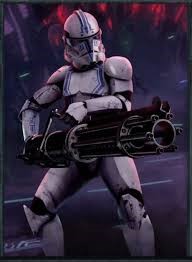
Hardcase
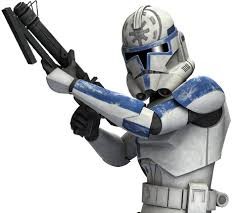
Jesse
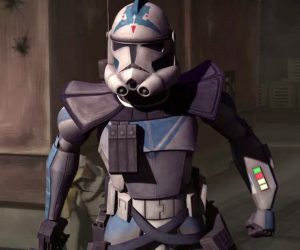
Fives
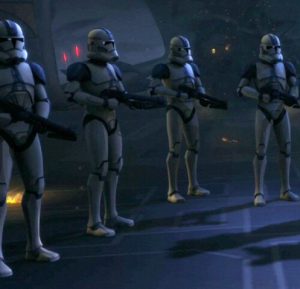
Standard soldiers of the 501st Legion
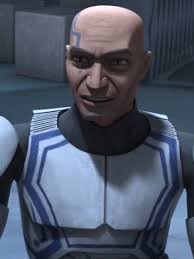
Hardcase without his helmet

Jesse without his helmet
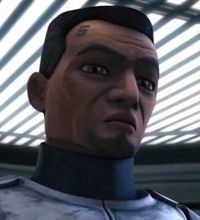
Fives without his helmet
Jesse has the symbol of the republic on his helmet while Hardcase’s helmet loses the single centered blue line of most legion troops for two thinner lines on the right and left on his helmet. This uniqueness also displays itself on their bodies, even though they are all biologically identical. Some clones like Jesse and Hardcase decide to shave their heads, while others like Fives prefer a buzzcut. All three also use tattoos to differentiate themselves, from a small five on a temple to a massive republic symbol covering half of their face. Despite having the same body, clones find ways to make themselves different. And these differences in their names, armor, bodies, and faces create unique characters, to each other and the audience. People can now recognize individuals among the army. They all still seem to exist as identical soldiers, wearing the same armor that covers the same body, but with this portrayal they exist as more than parts of a nameless white horde. Using methods borrowed from the Republic, clones subvert the expectation of being all the same being. The sameness becomes a canvas for them to create a unique being. And this uniqueness extends beyond the physical, when clones begin to not just look like individuals, but act like them as well.
Together with their physical differences, clones express their hybridity through the expression of their character and autonomy, even when it questions authority. This is then tested as General Krell only sees clones as tools for victory, forcing Captain Rex and the 501st Legion to use their hybridity to challenge Krell’s authority while serving themselves and the Republic. Krell leads his army from behind, but demands his soldiers take the most direct line of assault, and to never retreat regardless of enemy resistance (“Darkness on Umbara,” 8’50”). Any sign of hesitation is just a result of “feeble minded clones” (18’50”). In his eyes victory is worth any loss of clone lives. He only sees clones as they are in the prequels: unquestioning soldiers. While being bred as perfect soldiers, the clones with their developed sense of identity see themselves as more than “a bunch of unthinking droids” (“Plan of Dissent”, 4’22”). The soldiers constantly bemoan their suicidal orders, but Rex reluctantly orders his troops to obey, as they “have a duty to follow orders” (“The General,” 4’30”). The troopers under his command, however, begin to see things differently.
This scene first helps explore the different personalities of all the troopers. Fives trusts in his plan even though it goes against orders. Jesse cracks a joke about Hardcase but still agrees with Fives. Tup displays his apprehension about doing anything incredibly risky. Rex expresses his frustration with the situation and the system, but still believes in it. Dogma walks in looking for any trace of insubordination, as he trusts orders above all else. These clones have their own thoughts and opinions about the mission, and express their different personalities. But more importantly this clip exemplifies how Fives uses his hybridity to subvert the role he is expected to play as a clone. He outright rejects the notion that he can only support the war through following orders. He recognizes that clones are “more than just another number,” that they have value beyond their nature as a soldier, and that they should be allowed to contest orders that needlessly kill them. And Fives, along with Hardcase and Jesse, ignore Krell’s orders and use enemy bombers to take out a tank brigade and orbital supply base. They use their agency as individuals to formulate their own plan and execute it. But they do not wholly reject the institutions that forced them into these situations. All three clones risk their lives fighting for the Republic, and Hardcase dies for it. Fives and Jesse accept their court-martialing. They are soldiers who fight for the government they serve. But due to their individuality and autonomy, they want to fight in ways that value their being, instead of being treated as expendable tools. And through this hybridity of being a unique, autonomous individual and one of countless soldiers, the clones redefine what it means to be a soldier in Star Wars.
But there are always possible counter arguments when it come to this interpretation of the cartoon. One possible issue would be that for every clone given a chance to express themselves, there are thirty identical troops gunned down with little notice. Though some clones are treated differently, there are still countless portrayed identically to the clones of the prequels. Though this is most likely due to the scale of the show, and it would be impossible to create over 100 different characters over the course of eighty minutes of television. Despite that, these episodes of “The Clone Wars” specifically focus on clone’s individuality when the Prequels never made any attempt. In conjunction with the other clone characters featured over the course of the show, one can assume this individuality holds for all clones, if not explicitly displayed by all of them. Another possible point of contention would be the reveal that Krell was only issuing suicidal orders because he planned to betray the Republic and lose the campaign. This complicates the portrayal of the Republic as an institution indifferent to the lives of clones, as the character representing the Republic and this viewpoint was trying to undermine and betray the Republic through the use of these tactics. But the acceptance of Krell’s tactics by most of the clones demonstrates that regardless of Krell’s plans, clones are expected to follow orders even when the orders recklessly endanger their lives. And the defenses Rex and Dogma give demonstrate that clones are trained to prioritize the chain of command above their own being, regardless of the consequences.
Though originally portrayed as mindless, faceless soldiers in the prequels, “The Clone Wars” developed the characters of clone troopers through the use of hybridity. They are still soldiers with the same armor and genetics, but now they can personalize their appearance and express their autonomy within the army they serve. They have become a hybrid between identical soldiers and unique individuals. And with this portrayal they become meaningful characters in their part of the Star Wars narrative. Their legacy continues to flourish with Disney’s acquisition. Soldiers of all kinds are given the stage to tell their stories in mainstream Star Wars media. Finn and Poe are central characters to the new trilogy when before stormtroopers and pilots were barely given any significant characterization. Cassian Andor stars in Rogue One after Captain Antilles was the only named rebel soldier in the entire original trilogy, who perishes moments after he is introduced on screen. Even Rose, a mechanic who would have only had a few frames of screen time in the original movies, can explore her own narrative. The heroes of Star Wars are not just the Jedi, the princesses, and the smugglers anymore, but also the soldiers, pilots, and mechanics. All of this truly began with “The Clone Wars.” Perhaps this is a sign of the democratization of stories, fiction or nonfiction, in the mainstream. No longer are the only stories worth telling or titular heroes or great men of the past. The stories of this world are comprised of countless actors, all with some unique aspect to tell. Regardless, one can only hope to see how this trend in Star Wars can continue, and what new stories it will bring.
Works Cited
Bhabha, Homi K. “Signs Taken for Wonders: Questions of Ambivalence and Authority under a Tree Outside Delhi, May 1817.” Critical Inquiry, vol. 12, no. 1, 1985, pp. 144–165. JSTOR, JSTOR, www.jstor.org/stable/1343466.
“Clone Troopers.” Star Wars, Lucasfilm, 2011, web.archive.org/web/20110724063805/http://www.starwars.com/databank/organization/clonetroopers/index.html.
“Carnage of Krell.” The Clone Wars, season 4, episode 10, Cartoon Network, 18 Nov. 2011. Netflix, https://www.netflix.com/watch/70262944
“Darkness on Umbara.” The Clone Wars, season 4, episode 7, Cartoon Network, 28 Oct. 2011. Netflix, https://www.netflix.com/watch/70262941.
Kleiner, Carolyn. “Making Movie Magic.” U.S. News & World Report, vol. 126, no. 20, May 1999, p. 58. EBSCOhost, search.ebscohost.com/login.aspx?direct=true&db=f3h&AN=1843233&site=ehost-live.
Lucas, George, Director. Star Wars: Episode II – Attack of the Clones. Twentieth Century Fox, 2002.
“Plan of Dissent.” The Clone Wars, season 4, episode 9, Cartoon Network, 11 Nov. 2011. Netflix, https://www.netflix.com/watch/70262943
“The General.” The Clone Wars, season 4, episode 8, Cartoon Network, 4 Nov. 2011. Netflix, https://www.netflix.com/watch/70262942
Young, Robert J. C. Postcolonialism: A Very Short Introduction. Oxford University Press, 2010.

Clone Troopers and Hybridity – Response
The concept of the Clone Troopers is intriguing: thousands of identical perfect super soldiers that obey every order. At least, that is what is expected of them. In the prequels, they are demonstrated to being loyal to their masters, to a fault. In fact, the largest turning point in the prequels is dependent upon this fact. Emperor Palpatine’s Order 66: Operation Nightfall required all clones to betray their masters/leader Jedis and systematically murder them, thus creating a genocide of the Jedi. In Declan’s essay, he argues that the Clones are a product of hybridity: there is a dichotomy between the uniformity of the Clone Army, and the individual personalities that each clone has. These individual personalities are not demonstrated in the prequel trilogy. Rather, they are expanded upon in the Clone Wars television series. This series takes a look at the Clones as if they are any other soldiers. Aside from the fact that they all look moderately alike, because they come from the same original clone, and that they are all voiced by Dee Bradley Baker, these clones are shown to have personality. Although this is true, and it was demonstrated in the show that they have some sort of restricted free will, I argue that their identity is not truly a hybrid of the Republic and individuality, I argue that although they have exemplified behavior of free thinking, their programming is too strong to break, and at the end of the day, they are at the whim of their commanders. This is best proven through analyzing Order 66: and how almost all clones obeyed the order, aside from Commander Cody.
In Josh’s essay about droids and their own sense of hybridity, he mentions how the light and dark side represent the different sides of these hybrids, “On the side of the Rebellion and Republic, the portrayal of droids in Star Wars demonstrates the pluralist values of the protagonists. Conversely, the portrayal of droids on the sides of the Trade Federation, Separatists, and Empire demonstrates the antagonists’ views of droids as objects and tools” (Gamble). This same concept can be seen in the Clones. Although always under the control of their leaders, the Clones are shown to be loyal and successful at their duties throughout the Clone Wars. It is not until Palpatine’s initial moves to turn the Republic to the Dark side is when the negative effects are shown. But, that being said, the individualism that Declan speaks of in his essay is only seen sparingly in the television series. The best example of individual thought in the prequels is with Commander Cody, who has the mental restraint to shoot just below his former leader Obi Wan Kenobi (Episode III: Revenge of the Sith).
An interesting facet of Declan’s argument is about physical appearance. This is a very concrete demonstration of hybridity, because all of the clones are identical genetically, but they choose to represent themselves in different ways. In the show, certain soldiers have shaved heads and large face tattoos, while some have buzz cuts and smaller tattoos on their temples. All of these indicators are concrete examples of how they attempt to have their own individual identities, despite always being used at the whim of their leaders/the Republic as a whole.
Works Cited
Star Wars: Episode III – Revenge of the Sith. Dir. George Lucas. Perf. Hayden Christensen, Natalie Portman, Ewan McGregor, and Samuel L. Jackson. LucasFilm Ltd. 2005.
Cassidy, Declan. “More Than Just a Number: The Evolution of the Hybrid Identity of Clones”. Postcolonial Star Wars. Published December 12, 2018. http://pages.vassar.edu/postcolonialstarwars/fall-2018/declan-cassidy/
Gamble, Josh. “Individuality vs. Conformity: An Exploration of the Hybridity of Droids in Star Wars”. Postcolonial Star Wars. Published December 12, 2018. http://pages.vassar.edu/postcolonialstarwars/fall-2018/joshua-gamble/